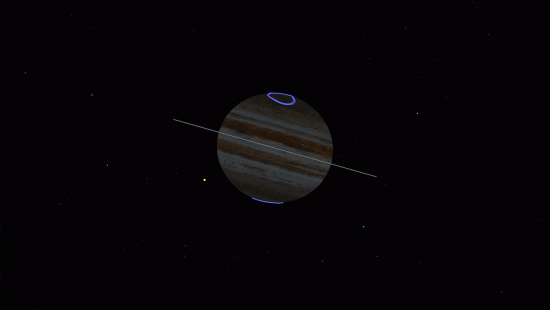
Nov 13, 2019
NASA launched the Juno mission to Jupiter on August 5, 2011. After a five-year flight, the spacecraft entered orbit on July 4, 2016.
Jupiter is the largest planet in the Solar System, with an equatorial diameter of 142,984 kilometers. It is so large that it could contain all of the other planets within its volume. Since Jupiter rotates in a mere 9.925 hours, its equatorial diameter is more than 9275 kilometers greater than the distance between its poles.
There are radiation belts around Jupiter, similar to the Van Allen radiation belts that surround Earth, except they are thousands of times more powerful. Juno’s electronics are, therefore, enclosed within a titanium shell, so that the energetic particles trapped around Jupiter will not interfere with its systems.
The most energetic particles in those belts are electrons that radiate in radio frequencies. This led to the discovery that Jupiter has a magnetic field. Electric Universe pioneer, Immanuel Velikovsky predicted the gas giant’s magnetic field in October 1953, as well as its powerful radio broadcast. Those phenomena are due to Jupiter’s magnetosphere, which extends outward for nearly 650 million kilometers, beyond Saturn’s orbit. Since no data about Jupiter’s electrical environment was available at the time, his commentary was truly insightful.
Jupiter’s rings are also electrical structures, formed out of a thin sheet of material. They are quite diffuse, so much so that they cannot be seen unless they are in correct alignment with the Sun. Their outer radius begins at 129,000 kilometers, about the same distance as the moon Adrastea. Consensus theories argue that the moons Metis, Adrastea, Amalthea and Thebe influence the structure of Jupiter’s rings in the same way that the “shepherd moons” of Saturn are thought to govern the shape of its rings. A previous Picture of the Day argues that Saturn’s rings are electrical formations, however.
The gas giant planets all have rings in some form or another. A plasma torus surrounds each of them, and the electric currents flowing along the polar axes and then out the equatorial plane are the likely cause for their persistence. No one knows for sure how planetary ring systems form and are maintained, but electricity flowing through dusty plasma can provide more reasonable explanations. The same holds true for the aurorae that also appear to be part of every planet.
As previously noted, the Galileo spacecraft discovered that the moon Io dissipates electric power greater than 2 trillion watts as it revolves through Jupiter’s electromagnetic fields. The electric charge flow travels along Jupiter’s magnetic field, creating lightning in the planet’s upper atmosphere, as well as intense aurorae at the poles.
All of these observations provide credible proof for an Electric Universe.
Stephen Smith
The Thunderbolts Picture of the Day is generously supported by the Mainwaring Archive Foundation.












